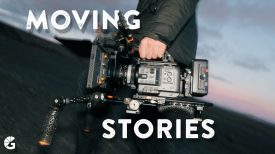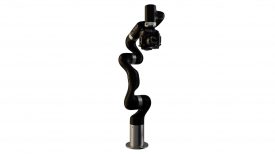By technical editor Matt Allard:
In the CBC series “The Great Human Odyssey”, the camera stays in constant motion, soaring above and moving through the worlds of traditional cultures and our ancient ancestors. The images are absolutely breathtaking and were filmed in some very remote locations. The three-part documentary series and interactive web documentary explores the unlikely survival and the miraculous emergence of Homo sapiens as the world’s only global species. Ancient climate research has revealed that we evolved during the most volatile era since the extinction of the dinosaurs. Just like the many other kinds of human who once shared our world, we should have died away. Instead, our species survived to populate every corner of the planet, against all the odds.
For aerials footage, the crew used the remote-controlled drone platform of Canadian company Skymotion. Capable of carrying a stabilized Red Epic shooting 5K footage, this flying camera system runs on portable batteries and packs into three suitcases for transport. The crew filmed ice floes on the Bering Strait, tuna-fishing boats in Papau New Guinea, sand dunes in Namibia, and in the back of a moving pick-up truck in the Kalahari Desert. Alongside Skymotion’s drone, ZatzWorks’ helicopter-mounted Cineflex system, carrying the Arri Alexa camera, provided aerial footage in high alpine, glacier, tundra and Pacific Ocean locations.
SkyMotion Video | 2015 Human Odyssey Reel from SkyMotion Video on Vimeo.
Nature often moves in ways the human eye cannot detect, but that specialized cameras can. For when the world moves too fast, the crew carries a high-speed camera, capable of capturing thousands of frames per second to create beautiful slow-motion sequences (Phantom’s new Miro 320S). For when the world moves too slowly, the crew carries a range of time-lapse tools. The standard tool is the Canon 5D MkIII and a set of motion-control heads and tracks, but we have also run super-long time lapses over the course of 3-4 months, in locations throughout western Canada, from mountaintops to larch forests to fern gardens.
Over 18 months of filming, Dr. Niobe Thompson followed in the footsteps of our ancestors across locations on five continents, working with 22 Canadian, American and South African cinematographers, including aerials, underwater, and ultra-slow motion specialists. Equipped with the next generation of ultraHD 4K cameras, film crews worked in some of the most hostile environments on Earth, including Arctic Siberia, remote South Pacific islands, tropical rainforests and African deserts.





